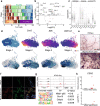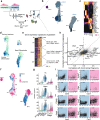Time-resolved single-cell analysis of Brca1 associated mammary tumourigenesis reveals aberrant differentiation of luminal progenitors
- PMID: 33686070
- PMCID: PMC7940427
- DOI: 10.1038/s41467-021-21783-3
Time-resolved single-cell analysis of Brca1 associated mammary tumourigenesis reveals aberrant differentiation of luminal progenitors
Abstract
It is unclear how genetic aberrations impact the state of nascent tumour cells and their microenvironment. BRCA1 driven triple negative breast cancer (TNBC) has been shown to arise from luminal progenitors yet little is known about how BRCA1 loss-of-function (LOF) and concomitant mutations affect the luminal progenitor cell state. Here we demonstrate how time-resolved single-cell profiling of genetically engineered mouse models before tumour formation can address this challenge. We found that perturbing Brca1/p53 in luminal progenitors induces aberrant alveolar differentiation pre-malignancy accompanied by pro-tumourigenic changes in the immune compartment. Unlike alveolar differentiation during gestation, this process is cell autonomous and characterised by the dysregulation of transcription factors driving alveologenesis. Based on our data we propose a model where Brca1/p53 LOF inadvertently promotes a differentiation program hardwired in luminal progenitors, highlighting the deterministic role of the cell-of-origin and offering a potential explanation for the tissue specificity of BRCA1 tumours.
Conflict of interest statement
The authors declare no competing interests.
Figures




References
Publication types
MeSH terms
Substances
Grants and funding
- MC_PC_17230/MRC_/Medical Research Council/United Kingdom
- BB/S006745/1/BB_/Biotechnology and Biological Sciences Research Council/United Kingdom
- MR/S036059/1/MRC_/Medical Research Council/United Kingdom
- A24995/CRUK_/Cancer Research UK/United Kingdom
- C47525/A17348/CRUK_/Cancer Research UK/United Kingdom
- WT_/Wellcome Trust/United Kingdom
- MR/M008975/1/MRC_/Medical Research Council/United Kingdom
- 16942/CRUK_/Cancer Research UK/United Kingdom
- 204622/Z/16/Z/WT_/Wellcome Trust/United Kingdom
- 17348/CRUK_/Cancer Research UK/United Kingdom
- 24995/CRUK_/Cancer Research UK/United Kingdom
- C9545/A29580/CRUK_/Cancer Research UK/United Kingdom
- 29567/CRUK_/Cancer Research UK/United Kingdom
LinkOut - more resources
Full Text Sources
Other Literature Sources
Medical
Molecular Biology Databases
Research Materials
Miscellaneous

